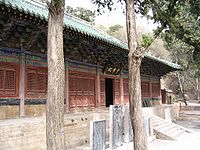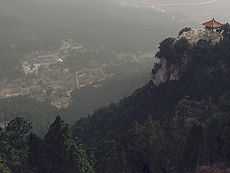
Lingyan Temple
Encyclopedia

Changqing District
Changqing is a district of the Chinese province of Shandong. It is administered by the sub provincial city of Jinan. It has an area of 1,178 km² and has 530,000 inhabitants .- External links :*...
, Jinan
Jinan
Jinan is the capital of Shandong province in Eastern China. The area of present-day Jinan has played an important role in the history of the region from the earliest beginnings of civilisation and has evolved into a major national administrative, economic, and transportation hub...
, Shandong
Shandong
' is a Province located on the eastern coast of the People's Republic of China. Shandong has played a major role in Chinese history from the beginning of Chinese civilization along the lower reaches of the Yellow River and served as a pivotal cultural and religious site for Taoism, Chinese...
Province, China
China
Chinese civilization may refer to:* China for more general discussion of the country.* Chinese culture* Greater China, the transnational community of ethnic Chinese.* History of China* Sinosphere, the area historically affected by Chinese culture...
, about 20 kilometres (12.4 mi) north of the city of Tai'an
Tai'an
Tai'an is a prefecture-level city in western Shandong province, People's Republic of China.Centered around Mount Tai, the city borders the provincial capital of Jinan to the north, Laiwu to the northeast, Zibo to the east, Linyi to the southeast, Liaocheng to the extreme west and Jining to the south...
. The temple grounds are situated in a valley on the western edge of the Taishan range
Mount Tai
Mount Tai is a mountain of historical and cultural significance located north of the city of Tai'an, in Shandong province, People's Republic of China. The tallest peak is the Jade Emperor Peak , which is commonly reported as tall, but is described by the PRC government as .Mount Tai is one of the...
. The Lingyan Temple has a long recorded history, and was one of the main temples in China during the times of the Tang and Song Dynasties. Its most renown landmarks are the 11th century Pizhi Pagoda
Pizhi Pagoda
The Pizhi Pagoda is an 11th century Chinese pagoda located at Lingyan Temple, Changqing, near Jinan, Shandong province, China. Although originally built in 753 during the reign of Emperor Xuanzong of Tang , the present pagoda is a Song Dynasty reconstruction from 1056 until 1063, during the last...
and the Thousand Buddha Hall which houses a Ming Dynasty
Ming Dynasty
The Ming Dynasty, also Empire of the Great Ming, was the ruling dynasty of China from 1368 to 1644, following the collapse of the Mongol-led Yuan Dynasty. The Ming, "one of the greatest eras of orderly government and social stability in human history", was the last dynasty in China ruled by ethnic...
bronze Buddha statue
Buddharupa
Buddharūpa is the Sanskrit and Pali term used in Buddhism for statues or models of the Buddha.-Commonalities:...
as well as 40 painted clay statues of life-size luohan
Luohan
Luohan can mean:* Luóhàn, the Chinese word for arhat, in Buddhism* Luohan or flowerhorn, a cichlid fish hybrid* Luohan , named after the Chinese word for arhat...
from the Song Dynasty
Song Dynasty
The Song Dynasty was a ruling dynasty in China between 960 and 1279; it succeeded the Five Dynasties and Ten Kingdoms Period, and was followed by the Yuan Dynasty. It was the first government in world history to issue banknotes or paper money, and the first Chinese government to establish a...
.
History

Fu Jian
Fu Jian may refer to:* Fú Jiàn , founding emperor of Former Qin, posthumous name Emperor Jingming* Fú Jiān , ruler of Former Qin, posthumous name Emperor Xuanzhao-See also:...
(r. 357–385) of the Former Qin
Former Qin
The Former Qin was a state of the Sixteen Kingdoms in China. Founded by the Fu family of the Di ethnicity, it completed the unification of North China in 376. Its capital had been Xi'an up to the death of the ruler Fu Jiān. Despite its name, the Former Qin was much later and less powerful than...
state. Gaining a greater reputation during the Northern Wei
Northern Wei
The Northern Wei Dynasty , also known as the Tuoba Wei , Later Wei , or Yuan Wei , was a dynasty which ruled northern China from 386 to 534 . It has been described as "part of an era of political turbulence and intense social and cultural change"...
(386–534), the temple reached its apex of importance during the Tang Dynasty
Tang Dynasty
The Tang Dynasty was an imperial dynasty of China preceded by the Sui Dynasty and followed by the Five Dynasties and Ten Kingdoms Period. It was founded by the Li family, who seized power during the decline and collapse of the Sui Empire...
(618–907) and Song Dynasty
Song Dynasty
The Song Dynasty was a ruling dynasty in China between 960 and 1279; it succeeded the Five Dynasties and Ten Kingdoms Period, and was followed by the Yuan Dynasty. It was the first government in world history to issue banknotes or paper money, and the first Chinese government to establish a...
(960–1279). There were over 40 different wooden temple halls located at the temple, composing more than 500 monastic rooms. More than 500 Buddhist monks
Bhikkhu
A Bhikkhu or Bhikṣu is an ordained male Buddhist monastic. A female monastic is called a Bhikkhuni Nepali: ). The life of Bhikkhus and Bhikkhunis is governed by a set of rules called the patimokkha within the vinaya's framework of monastic discipline...
lived at Lingyan Temple during its height. The oldest structures at the site are the various stone stupa
Stupa
A stupa is a mound-like structure containing Buddhist relics, typically the remains of Buddha, used by Buddhists as a place of worship....
s and square-based stone Chinese pagoda
Chinese pagoda
Chinese Pagodas are a traditional part of Chinese architecture. In addition to religious use, since ancient times Chinese pagodas have been praised for the spectacular views which they offer, and many famous poems in Chinese history attest to the joy of scaling pagodas.-History:The pagoda is...
in the pavilion style
Chinese pavilion
.Chinese Pavilions are covered structures without surrounding walls and are a traditional part of Chinese architecture. While often found within temples, pavilions are not exclusively religious structures...
from the Tang Dynasty, the 8th century Huichong Pagoda. Of the 167 stone stupas at the temple, no two are identical, and like the luohan statues of the Thousand Buddha Hall, have been well-preserved and untouched by the Cultural Revolution
Cultural Revolution
The Great Proletarian Cultural Revolution, commonly known as the Cultural Revolution , was a socio-political movement that took place in the People's Republic of China from 1966 through 1976...
. The tallest structure of the temple is the 54 m (177 ft) tall Pizhi Pagoda
Pizhi Pagoda
The Pizhi Pagoda is an 11th century Chinese pagoda located at Lingyan Temple, Changqing, near Jinan, Shandong province, China. Although originally built in 753 during the reign of Emperor Xuanzong of Tang , the present pagoda is a Song Dynasty reconstruction from 1056 until 1063, during the last...
, built originally in 753, although the present structure was built from 1056 to 1063. Although the wooden halls were all reconstructed during the Ming Dynasty
Ming Dynasty
The Ming Dynasty, also Empire of the Great Ming, was the ruling dynasty of China from 1368 to 1644, following the collapse of the Mongol-led Yuan Dynasty. The Ming, "one of the greatest eras of orderly government and social stability in human history", was the last dynasty in China ruled by ethnic...
(1368–1644) and Qing Dynasty
Qing Dynasty
The Qing Dynasty was the last dynasty of China, ruling from 1644 to 1912 with a brief, abortive restoration in 1917. It was preceded by the Ming Dynasty and followed by the Republic of China....
(1644–1912), the stone pedestals at the base of the pillars in the Thousand Buddha Hall are the original work of the Tang and Song eras.

